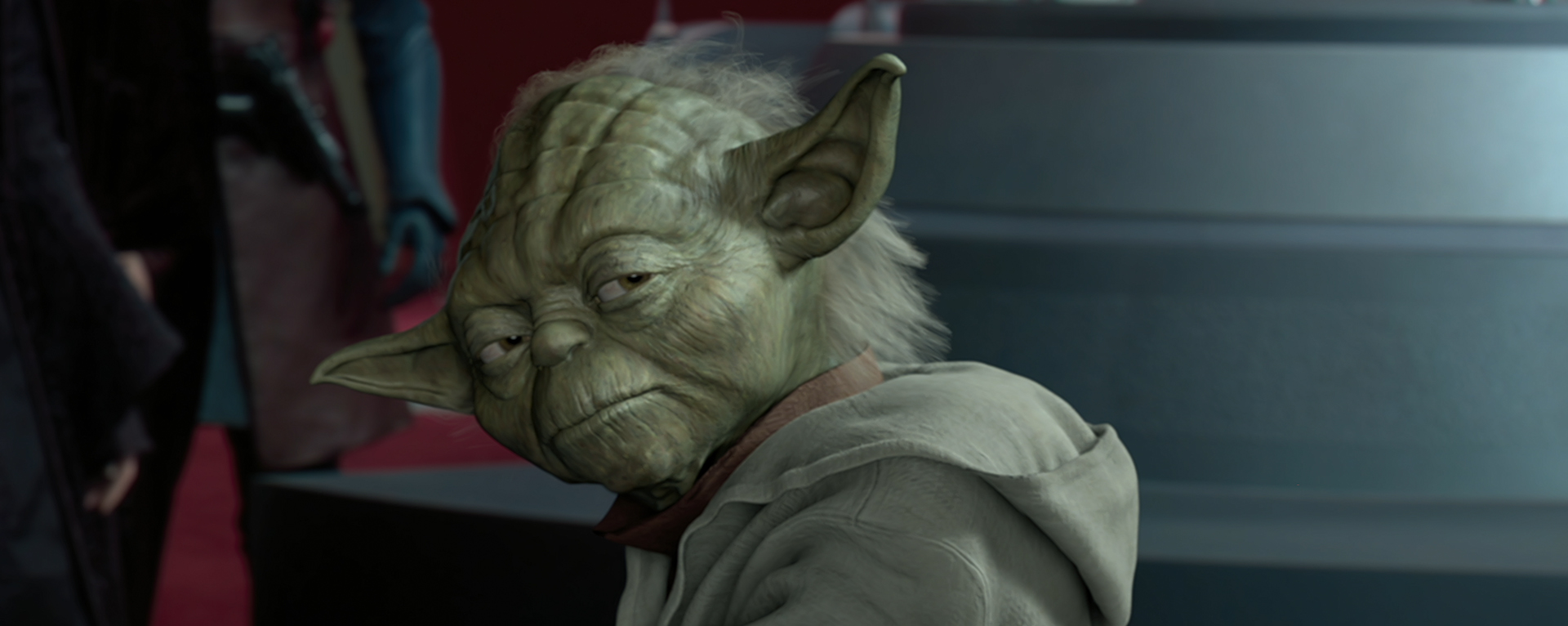Defining Moments: Yoda’s Stare
In A Character’s Performance, Expressions Can Speak Louder Than Words
Ever since their creation of the pseudopod in The Abyss (1989) or the villainous T1000 in Terminator 2: Judgement Day (1991), the visual effects artists and scientists at Industrial Light & Magic (ILM) had continued in the advancement of all-digital characters in their movie projects. Over time, creature-based performances such as the Tyrannosaurus Rex in Jurassic Park (1993) led to speaking character roles, including Draco the dragon in Dragonheart (1996) or Jar Jar Binks in Star Wars: The Phantom Menace (1999).
As Lucasfilm prepared Star Wars: Attack of the Clones (2002), director George Lucas was convinced of the ability to use fully computer-generated characters for main roles in a feature film. With the urging of ILM animation director Rob Coleman and the effects crew, Lucas agreed to create the familiar Master Yoda in Episode II in just such a manner.
Yoda first appears early in the film. After an assassination attempt on the city world of Coruscant fails to kill Padmé Amidala, the young Senator and her delegation meet with Chancellor Palpatine, who is busy discussing the current dangers threatening the Galactic Republic with members of the Jedi Council. Yoda himself confesses that the dark side of the Force has clouded his vision, and the future remains “impossible to see.”
As Senator Amidala and the Jedi trade theories on who was responsible for the failed assassination, Palpatine interrupts to suggest that perhaps the Jedi themselves would be suitable protection for the Senator. While Padmé questions the idea, the Chancellor insists, further suggesting that “an old friend” like Obi-Wan Kenobi (along with his Padawan Anakin Skywalker) would do well to keep her safe. In the midst of his remonstrations, the scene cuts to Yoda, voiceless but staring at Palpatine, a look of faint skepticism in his face.
According to Rob Coleman, this shot of Yoda became “one of George’s early favorites.” He explained that “the reason is because it’s acting. He’s not speaking, he’s acting, and you can tell he doesn’t quite trust what Palpatine is saying in this scene. I remember giving it to Lesley Headrick, one of my animators, and she wasn’t too keen on it because it wasn’t an acting-talking shot in her mind. I said, ‘You know, this is going to be one of the most important shots for Yoda early on in the movie, establishing that this is a legitimate, realistic character…’”
As Yoda had already attested, his view of the future remains vague and undefined, but in this moment, he seems to doubt the sincerity of Chancellor Palpatine. As members of the audience, we can more fully understand the hidden villain’s patient machinations as he maneuvers to attain more power and influence over young Anakin Skywalker. Though Yoda appears to sense uncertainty around the Chancellor, his vision remains tragically imprecise. As the story will reveal, the Jedi’s ultimate realization will come too late.
A cornerstone in animation is the pantomime scene, or a moment when a character’s believability relies entirely on their physical expression rather than spoken words. As Coleman noted, this shot of Yoda’s stare was important in convincing movie audiences that this digital Yoda was no different from the traditional puppet they’d grown accustomed to in past decades.
—

